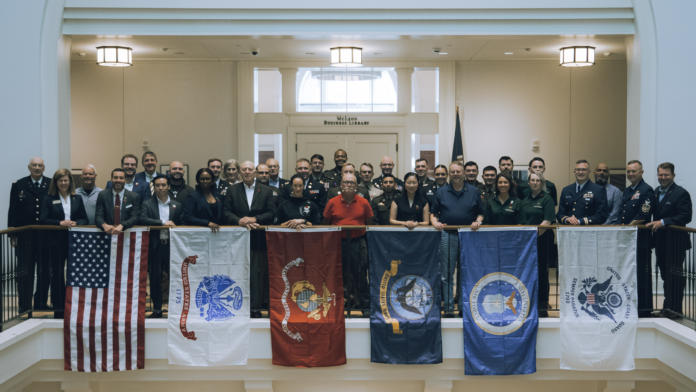Monday, Nov. 11, the College of William and Mary celebrated Veterans Day, recognizing the diverse journeys military veterans take as they transition from uniformed service to the classroom.
Throughout the day, events like the Wren Bell-Ringing ceremony at the Sir Christopher Wren Building, a Veterans Day observance at the College of William and Mary Law School, and a celebration at the Raymond A. Mason School of Business honored the military and veteran community, offering spaces for reflection and camaraderie.
Veterans Day, originally Armistice Day in 1919 to mark the end of World War I, became a holiday to honor all U.S. veterans in 1954. Its meaning has evolved from remembrance to collective action, solidarity and a broader commitment to veterans’ well-being.
At the Wren Bell-Ringing ceremony, veterans, students and faculty gathered to honor those who served.
Angelique Echols ’25, a retired Master-at-Arms in the U.S. Navy, spoke about continued service.
“We stand in solidarity and care about this country,” Echols said. “Our service may look different now, but we are here to engage, be policymakers, peacekeepers and advocates, not just for veterans, but for everyone.”
At the Mason School of Business, a Veterans Day ceremony highlighted veterans’ contributions to academia and professional life.
Cierra Klett MBA ’26, a retired Airman First Class, shared what Veterans Day means to her.
“It’s about service before self, even when it’s tough,” Klett said. “There are long nights and challenging moments, but it’s all worth it.”
Charlie Foster, director of the Office of Student Veteran Engagement, emphasized the importance of understanding diverse military experiences.
“I think asking questions and getting to know people’s stories and being open-minded will take anybody a long way,” Foster said.
Foster emphasized that dialogue is essential to breaking misconceptions and fostering empathy between veterans and civilians.
For veterans like Josue Jean ’25, a former aviation boatswain’s mate in the U.S. Navy, Veterans Day represents a moment of pride.
“Veterans Day means a lot to me,” Jean said. “It tells a story of a country dedicated to serving as a beacon of justice and light for the world.”
Jean reflected on his transition from the military emphasized community.
“As veterans, we rely on each other. We come from different backgrounds, but when we come together, we’re a unified force, committed to something bigger than ourselves,” Jean said.
The College’s support for veterans extends beyond one day of recognition. Its support systems help veterans transition from military life to academia.
The College is home to programs such as the Flourishing Through Life Transitions program, which is designed to assist veterans in navigating both academic rigor and reintegrating into civilian life. The Office of Student Veteran Engagement plays a pivotal role in providing resources such as specialized orientation, academic counseling and wellness programs tailored to veterans’ needs.
While Veterans Day is essential for honoring those who have served, Army 2nd Lt. Sean Evans ’24, a Reserved Officers’ Training Corp alumnus, shared his perspective on what the day should truly represent.
“I think it would be better if Veterans Day were less about acknowledging that veterans exist and more about how we can connect with veterans who may be struggling with mental health or physical issues,” Evans said.
Evans emphasized that Veterans Day should be an opportunity for civilians to reflect on how they can actively support veterans’ well-being, particularly those facing ongoing struggles.
“How can you serve your greater community?” Evans said. “And we are also tacitly participating in whether or not we acknowledge it.”
Evans’s call to action shifts the focus from ceremonial gestures to meaningful engagement with veterans’ needs, serving as a reminder that honoring veterans should extend year-round.
As part of this broader discussion, Evans also shared his concerns about the challenges ROTC cadets face, particularly when it comes to access to athletic facilities. While ROTC programs often conduct physical training on campus, Evans pointed out that the facilities available to cadets are limited compared to those offered to student athletes.
“ROTC does PT Tuesday, Wednesday, Thursday on the field,” Evans said. “But we have a small shed to store our equipment. It would be better, and other ROTC programs are afforded access to the athletic facilities that student-athletes have.”
Evans’s words highlight not only the logistical challenges ROTC cadets face balancing training with academic life, but also stress the importance of equitable resources for all students, regardless of their extracurricular commitments.

